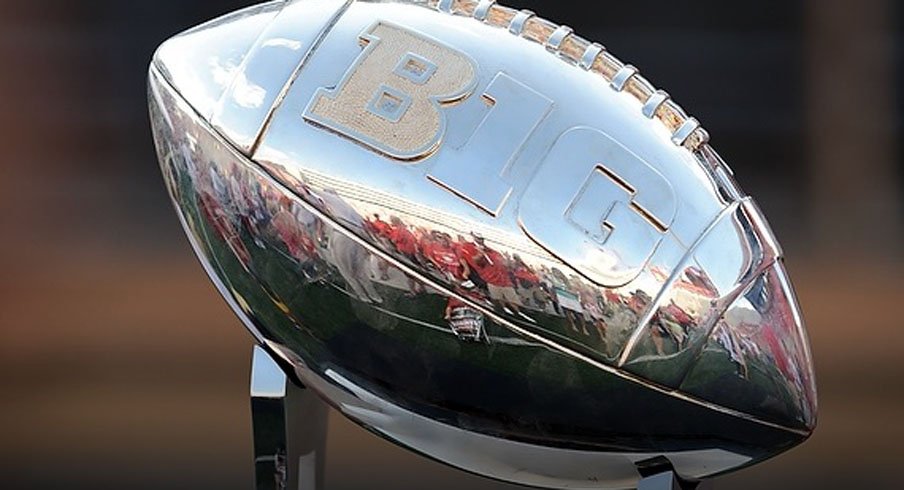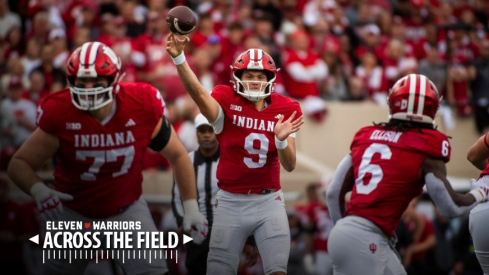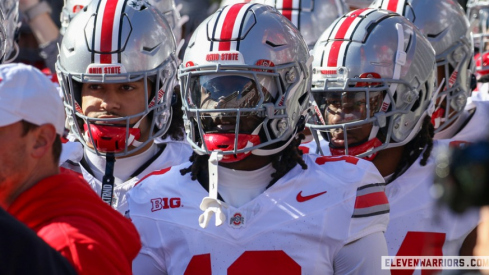CHICAGO – Indiana. Maryland. Rutgers. Not quite Leaders or Legends when it comes to all-time great college football programs.
But those three schools are now slotted in one of the sport’s toughest divisions – the up and coming Big Ten East.
Ohio State, Michigan, Michigan State and Penn State round off the vaunted group, perhaps marking a flashback to supremacy for the Big Ten. Geographic divisions have formed a powerhouse in the East and a wide-open West. Urban Meyer likened the looming grind of the Big Ten East to what he faced for six years in the SEC.
If Ohio State advances to the first ever College Football Playoff, it will have earned it. The Buckeyes play at Penn State and Michigan State – both at night – before a possible four-game string of Michigan, Big Ten championship and two playoff games.
“It’s one of the toughest divisions in college football,” Meyer said at Big Ten Media Days Monday. “I hope that happens, but that’s a tough road. It’s a rugged conference. We’re going to do our best to be prepared for it.”
Meanwhile, the West has five teams that could legitimately represent the division in Indianapolis. Wisconsin and Iowa, two favorites, don’t play Ohio State, Michigan, Michigan State or Penn State.
Go figure.
It’s the new reality in the conference, something SEC programs have faced for two decades. When divisions are split and the number of teams grows, there will be long gaps in series and favorable schedules.
As the East grew into the theme of media days, Wisconsin head coach Gary Andersen is of the belief the West is dealing with a lack of respect. But if the Badgers can sneak under the radar and enter the Big Ten Championship Game with little fanfare, you won’t find him complaining.
“We’re all going to put our helmets on and go out on play,” Andersen said. “That will define this year’s teams. So to sit here now and say this division is this and this division is that based off traditions of a school, I don't buy that. There’s tremendous tradition on both sides. We’ll all fight it out in the defining moment and we’ll see who’s who.”
Andersen expanded, saying there are no easy games in the Big Ten while sniping at pundits who think the conference is full of glorified bye weeks.
“I’ll debate that with you as much as you want to debate it because you better strap it on and be ready every week in the Big Ten,” he said.
Indiana head coach Kevin Wilson agrees, especially since he drew the short end of the geography stick and must face the four power programs. The Hoosiers have improved of each of Wilson’s three seasons in Bloomington, but bowl eligibility has remained elusive. In the Big Ten, they haven’t been able to win the 50/50 games that marginal teams must capture to separate themselves from mediocrity.
Now Indiana will have four games on its schedule each season that are almost certain losses. Still, it hasn’t dampened Wilson’s spirit. He thinks there are recruiting advantages and opportunities to grow Indiana football into a perennial winner.
“We're excited to be part of the Big Ten East,” Wilson said. “We’re really excited with the opportunity with Michigan, Michigan State, Ohio State, Penn State, Maryland and Rutgers and the East brand growing.”
That brand is one reason why the conference grew by two teams and significantly eastward. Rutgers and Maryland offer the Big Ten a footprint in two cities – New York and Washington – where the league was previously nonexistent. It means piles of cash and more eyeballs on the Big Ten.
Ask Ohio State athletic director Gene Smith to expound on expansion, and he’ll openly admit money was the impetus. But he and conference commissioner Jim Delany don’t believe there will be an imbalance issue for the coming years. Sports have a way of working out the kinks, with cycles of dominance coming and going.
“We’ve had nine different teams play in the Rose Bowl [since 1990],” Delany said. “I’ve seen the strength of teams ebb and flow. The SEC has been doing their divisions for 22 or 23 years, and for a longtime the East was dominant and then the West was dominant.”
Even players have taken notice to the divisional lineup. In a 24/7 news cycle with information at their fingertips, they’ve read Twitter and know what lies ahead. Michigan quarterback Devin Gardner called the East “high-intensity.” Michigan State safety Kurtis Drummond acknowledged the amount of difficult games, but said he’s only focused on Jacksonville State, an FCS team the Spartans open with.
“Obviously our rivalry with Michigan is intense for us, but we've also got a rivalry with Ohio State from the past and Penn State,” said Michigan State head coach Mark Dantonio. “So those things exist for us. I think it’s going to be a tough division. There’s no question about that.”
For the second consecutive season, it’s a tad tougher for Michigan, who must travel to East Lansing once again. It’d an oddity that occurred due to Rutgers and Maryland joining the conference and schedules being rearranged. But Hoke isn’t complaining.
“Who cares? You’re going to play 12 football games, right?” he said. “When those decisions are made, embrace it. If not, you’re going to make excuses, and we, rightfully, don’t believe in excuses.
“All want to do is we want to compete. We want to compete on every Saturday. So as far as we’re concerned, we’re looking forward to [playing in the East].”
For at least one season, Dantonio and Co. will consider themselves the Beasts of the East. Conference titles are welcomed, but Dantonio is aware of the danger that lurks behind.
“I think we’re a little bit more of the hunted,” he said. “That’s a good place to be, but it’s also a very precarious place to be.”


